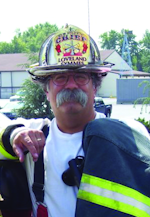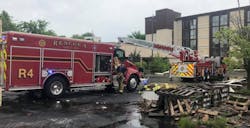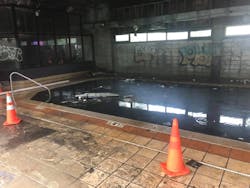Swimming pools at the scene of structure fires always have been a hazard for firefighters. My first “pool on scene” experience occurred in 1975 when a firefighter fell into a pool at a night fire. Fast forward to June 2020, when an in-ground pool was in play at a working dwelling fire. Fortunately, because this incident took place in the daylight, our risk was rather limited.
The conditions were much different in May 2020 when two Joplin, MO, Fire Department (JFD) firefighters, who were operating at a fire at an abandoned hotel, fell into the rancid water of a pool. Members encountered heavy smoke coming from the enclosed pool area.
One of the JFD’s challenges seems to be a large transient population and several vacant and run-down structures throughout the city.
Our sincere thanks to the entire JFD membership, with special appreciation to Chief of Department James Furgerson, Capt. John Miles and Firefighter Kent Shouse.
The initial alarm
On May 15, at 4:14 p.m., JFD Ladder 5, Rescue 4, Engine 4, Engine 3 and Battalion 1 and Redings Mill Fire Protection District (one engine company providing automatic aid) responded to a report of a possible structure fire at the abandoned hotel. The first crew arrived to find smoke showing from the enclosed pool area. (Crews ultimately would extinguish a burning pile of wire. The cause of the fire was ruled as transients burning wire to expose the wire’s copper.)
Miles responded as the captain of Ladder 5 with Rescue 4, and Furgerson responded, covering as Battalion 1. They knew that this building was unoccupied for several years and was used by transients and looters, thus requiring search.
At one point, after the hotel went out of business, remodeling was begun, but construction was halted long before this incident. The rear of the structure, which is the area where the smoke was reported, was closed off by gates and fencing.
Furgerson arrived on scene at 4:24 p.m. to find moderate smoke coming from the B side of the building. The hotel was six stories tall, but the area of the building that had smoke showing was a single story. The smoke wasn’t turbulent and was very light in color.
Account from Capt. John Miles
Upon arrival, we found the fence that was at the rear of the structure was removed, so we could access the needed area without issue. Ladder 5 pulled around and found smoke coming from the roof area and multiple windows of a smaller building that was connected to the main structure.
Ladder 5 set up for operation, and Rescue 4 filled out an initial rapid-intervention team (RIT). My firefighter, Kent Shouse, and I performed a walk around of the structure, and we located the seat of the fire from the exterior. I assigned Rescue 4 to the roof to investigate HVAC units that were on the top of the structure as well as set up for possible vertical ventilation.
Shouse and I entered the structure. We encountered heavy smoke conditions but no visible fire and very little heat. Knowing that the structure was vacant and lacked utilities, there was no mechanical reason for a fire. I was concerned that there might be people inside, so we began a hasty search.
I was equipped with a FLIR thermal imaging camera (TIC) and Halligan bar, and Shouse had a 1¾-inch charged handline. We swept the immediate area and found no sign of victims or the fire. The ceiling of the structure was approximately 20 feet in height, so smoke was only banked down to just below eye level.
Sweeping with the TIC, I could see a large room with debris throughout but no signs of fire or victims. I contacted the roof company, and they advised that the fire appeared to be on the B/C corner of the structure and that the HVAC system didn’t appear to be involved. The roof division also advised that the roof was “no good” for operation, because it couldn’t support their weight; they would work to open a large skylight for ventilation if ordered.
Using the TIC, I noted that the location of the skylight was directly above my location. I then told Shouse that we would proceed to the west through the structure.
I took roughly four steps when I felt myself falling. Initially, I believed that the floor gave way. Then I felt water up to my waist. I yelled for Shouse to stop, but he wasn’t able to hear me over the sound of me entering the water. I felt myself hit the bottom of the pool and begin to slide. I immediately flipped myself over on to my stomach, thinking that, if I could use both of my hands and feet, I could push myself up at least into an upright position. I did, and I was able to stand with my eyes about an inch out of the water. My mask maintained seal throughout.
As I made it to the surface, I saw Shouse fall into the pool from a crouched position. (He saw my helmet and 90-degree light as I fell and attempted to catch me.) As he fell into the water, I was able to grab his left leg and pull him up immediately. I searched and finally found the edge of the pool and immediately attempted a mayday call. Because my radio was underwater, I concluded that I wasn’t able to transmit. Shouse concluded the same thing.I remembered that the roof crew was almost directly above me, and I yelled to them to call a mayday.
I was able to pull myself up on the edge of the pool while maintaining contact with Shouse and swing my hip where my radio was located out of the water and attempted another mayday, which immediately was received and confirmed.
(I found out after the event that the roof crew did hear the first mayday over the radio and verbally contacted the RIT).
I pulled Shouse out of the pool and asked was he OK and was his mask intact. He advised that he was OK and that the mask still was sealed. At that point, I cancelled the mayday, because I didn’t want the RIT rushing in and ending up in the pool, too.
Shouse and I exited the structure and immediately were assessed. Neither of us sustained any injuries, and, once we regrouped and were joined by the rescue crew, we made entry from a different door to the structure, and we located the fire in a small room with glass walls.
The fire consisted of rolls of data cable. During this operation, I had my Rescue 4 driver, who had the TIC off of the rescue with him, sweep the structure, and it was noted that there was no indication of a pool with that TIC either.
We both were taken aback by this: My inability initially to see the pool could have been a result of a setting having changed or some issue with the TIC that I had; immediately able to replicate the inability to see the pool with a different unit brought me some peace of mind.
It is my opinion that conditions were just right for this to happen: The ambient air temperature was cool for the time of the year, and I believe that led to the concrete that surrounds the pool, coupled with the film of debris on the water, to show in the thermal as within the temperature variant in the TIC itself. In TIC training, we used water multiple times to simulate a hole in a floor, so we were well-versed in what water looks like on a TIC. That certainly wasn’t what we saw on May 15.
Comments from Chief Goldfeder
In a discussion that I had with Furgerson, he stated, “I have been on the fire department for over 19 years, and this is the first time I have ever been on an actual scene that a mayday was called, and I felt it went very well. We had a formal RIT team established, and they were in the process of deploying when the mayday was cleared. It is truly heart-stopping to hear those words come over the radio, and I was extremely proud of how our personnel responded; it didn’t become chaotic, and the firefighters went right to work.”
There are numerous challenges that are related to this kind of run. The abandoned structure creates a “who knows?” environment for members who operate on scene. The heavy smoke conditions and the confined space in the swimming pool area (unmaintained, no lighting, no one on scene, such as hotel management, to provide direction, etc.) further complicate it. Add the bunker gear (wet and weighted) and the nasty, rancid water conditions, and it’s a recipe for problems.
Going inside was required at this fire based on the conditions, known homeless (because of previous history) and the size-up.
This wasn’t a well-involved building. The JFD followed the normal routine of locate, confine and extinguish the fire; however, they understood the predictable additional hazards that can be found in vacant buildings. Unfortunately, a swimming pool got in the way.
Consider the factors that the JFD faced related to the thermal imager, the radios and visibility. The members knew the building conditions, but, because of the smoke, the pool became an issue. Isn’t it interesting that Miles and Shouse believed that their radios failed when they hit the water?
Note Miles’ good decision to cancel the mayday to limit exposure and problems to other members after he and Shouse self-extricated and were safe.
With the COVID-19 related trend for corporations to have people work from home and to be less reliant on commercial properties, operating at fires in “abandoned” large-area structures will increase. As the late fire-protection expert Frank Brannigan told us years ago “A building is a firefighter’s enemy; know your enemy.”
Abandoned
Vacant property fires are a big deal to every firefighter and department. According to the NFPA, in 2011–2015, U.S. departments responded to an estimated average of 30,200 structure fires in vacant properties per year, and those resulted in 60 civilian deaths and 160 civilian injuries. An estimated average of 3,310 firefighters were injured at vacant building fires per year during the time period.

Billy Goldfeder
BILLY GOLDFEDER, EFO, who is a Firehouse contributing editor, has been a firefighter since 1973 and a chief officer since 1982. He is deputy fire chief of the Loveland-Symmes Fire Department in Ohio, which is an ISO Class 1, CPSE and CAAS-accredited department. Goldfeder has served on numerous NFPA and International Association of Fire Chiefs (IAFC) committees. He is on the board of directors of the IAFC Safety, Health and Survival Section and the National Fallen Firefighters Foundation.








